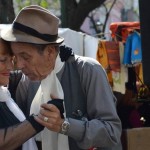Washington State’s Sakai Middle School says the community supports its internment curriculum. An outspoken opponent is barred from school property.By LYNDA LIN , Assistant Editor
For some, Japanese American history is more than just a paragraph in a book. Two weeks out of the year, students at Sakai Middle School on Bainbridge Island are transported back to the bleak barracks of the World War II era internment where they can hear echoes of the past. And although some parents want to yank the children back from the journey, school officials and community members maintain that the program is an important part of the island’s unique history. The “Leaving Our Island” curriculum, which started in 2004 through grant money, put Sakai Middle School on a short list of schools that dedicate more to teaching internment history than just reading. The interactive program is a part of the school’s sixth grade social studies curriculum, which requires students to adopt JA family identities, trek through museum field trips and converse with former JA internees and their descendents. Before the program’s inception, Principal Jo Vander Stoep said the only reference to internment was a paragraph in their social studies books. The picturesque island, a 35-minute ferry ride from Seattle, was the first site in the United States to see its JAs forcibly removed from their homes. Two hundred twenty seven Bainbridge Island JAs boarded a ferry in 1942 and sailed away to Manzanar. Since then, the community has worn its history on its sleeves. Sakai Middle School itself is named after Sonoji Sakai, a longtime Bainbridge resident and community leader who died in 1953. The “Leaving Our Island” curriculum is one of the ways the school honors his and the island’s legacy. “It’s where what they read and hear in history class comes alive,” said Vander Stoep. “I cannot imagine teaching World War II history of the United States and not having a curriculum about the internment.” But others feel differently and object loudly to what they believe is a one-sided take on American history. Recently, the quiet island of a little over 20,000 residents was besieged with national attention and became known as a divided community. Headlines screamed about showdowns between parent and school officials and internment debates. Current Bainbridge JA residents who attended internment camp reunions and community events were asked about the island’s problem with racism. But longtime Bainbridge resident Dr. Frank Kitamoto said the issue was more a ripple in the water than a gale storm of controversy. “Less than five percent of the island was against the curriculum and of those, half live off the island,” said Kitamoto, who is also the president of the Bainbridge Island Japanese American Community (BIJAC). “It’s just been two people who have asked a lot of questions,” added Vander Stoep. Those two people — Captain James Olsen and his wife Mary Dombrowski — have been the main agitators in the fight against the curriculum. The couple, whose daughter attends Sakai, has battled school officials about its teaching on the internment as a mistake made by the U.S. government. They call the curriculum “propaganda” and rallied enough support to get the Bainbridge Island School Board to recommend revisions to the curriculum. The school agreed to make the curriculum a more concise lesson that puts the internment into context about how the decision was made at the time, and to soften the connection with present day national security issues. Olsen, who was not satisfied with the revisions, finally caused enough disruption Feb. 9 to be barred from school district property indefinitely. On that day, a panel of speakers from the Bainbridge Island JA community was scheduled to talk about their experiences as a part of the curriculum. Olsen arrived at Sakai with a tape recorder and a microphone, but was turned away by the police and school officials. “By reason of recent conduct, behavior and rhetoric, we believe there was sufficient cause to deny Captain Olsen access to our schools. We felt the likelihood of disruption was, and is, real,” said Superintendent Dr. Ken Crawford in an official statement. Under school policy and procedures, the principal can order the person to be removed from school property, but Olsen told local press that being kept out of his own child’s classroom was a discriminatory act that violated his civil rights. He is reportedly planning to meet with an attorney. However, the odds are stacked against Olsen, said Aaron RS Lorenz, professor at the University of Massachusetts Amherst Department of Legal Studies. He said that the school has the right to sanction parents and in this case, bar Olsen because of his actions not his beliefs. Vander Stoep, who calls herself the “gatekeeper,” said the curriculum will continue in future years. Olsen and Dombrowski are a part of a reemerging group who maintain that the United States made the right decision in the name of national security to intern hundred of thousands of JAs. Perhaps the most recent ringleader is Michelle Malkin whose book “In Defense of Internment” was reportedly influential to Olsen and Dombrowski. John Hawkins, who runs www.rightwingnews.com, credits Malkin’s book for spurring people to rethink the internment. “The Japanese internment was an important history event that students should learn about. Unfortunately, our kids are often not told of the unique set of historical circumstances that led to the internment and are incorrectly led to believe that it was simply based on racism. For students to truly understand the Japanese internment, they have to be presented with all the relevant facts,” said Hawkins. In democracy, there is always freedom of expression. However, JACL Executive Director John Tateishi said there is danger in this point of view. “Those who defend the internment or refuse to accept that the government’s actions were racist and unjustified blind themselves to historical truth because they have some kind of perverted need to believe that Japanese Americans aren’t quite equal to them as citizens of this nation,” said Tateishi. “One could argue that they provide a forum for opening up the debate once again, but we’ve been through that. We’ve been debating that for sixty years. But as long as there are racists in this country, and there always will be, I suppose that this is an issue that won’t go away,” he added. Kitamoto said the debate at Sakai has its pluses and minuses. On the one hand, it shows how people are still prejudice. On the other, it makes the curriculum more important to teach. As president of BIJAC, Kitamoto helped Sakai develop the internment curriculum. He gives a slide show presentation on the internment and multicultural issues to the students every year and said the students enjoy having history come to life. “Kids are smart. They can come to a certain conclusion on their own. Teachers aren’t planting ideas in their minds,” he said.
Other Readings of Interest
|
||
|











